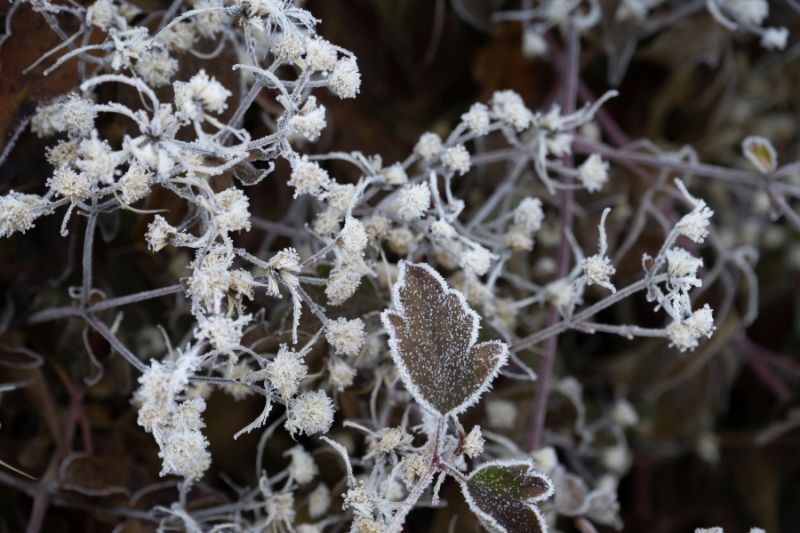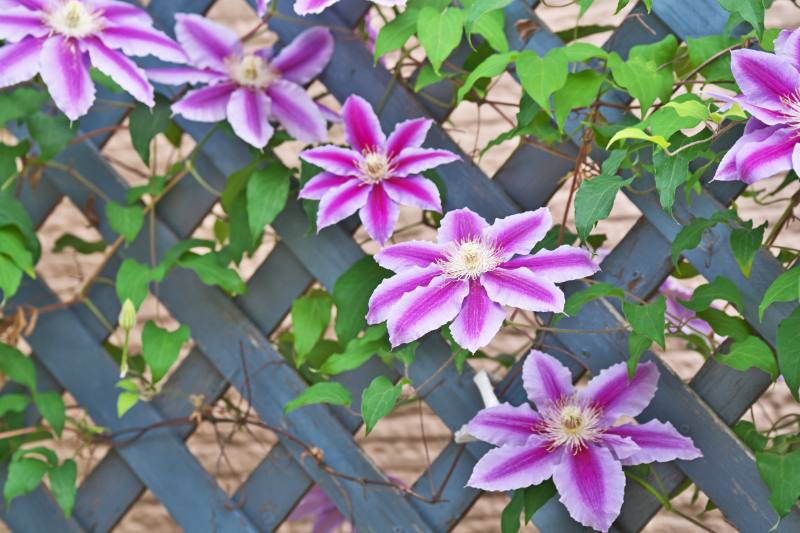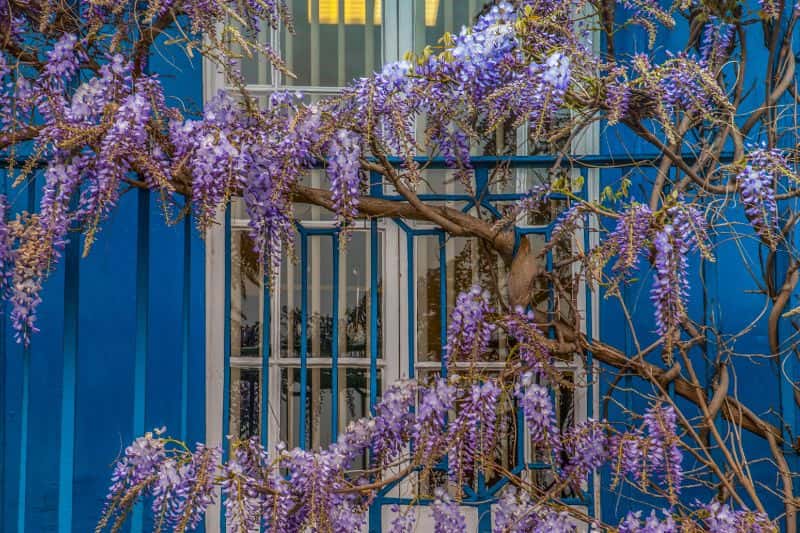Do you dream of a wall covered in flowering climbing plants or a pergola overrun with lush greenery? It’s a lovely project… but things can quickly go awry if you don’t approach it correctly. Let’s be honest: between the jasmine that prefers to crawl rather than climb, the clematis that wilts in a few days, and the wisteria that turns into an invasive monster, there are plenty of stories to tell… So, if you’re ready to fail with flair, to turn your dreams of greenery into memorable plant disasters, follow the guide!
And if, along the way, you decide that planting your climbers correctly wouldn’t be such a bad idea, don’t worry: just do the exact opposite of everything we’re about to tell you here!
Let’s go, the glory of horticultural failure awaits you!
Choose your plant at random: the foundation of failure
If you want to ensure your climbers don’t survive, start by choosing your plant solely based on its appearance or the impulse buy you made at the garden centre. Who needs to wonder if that stunning bougainvillea can survive in your Alsatian garden? Not you, of course!
Why rely on the ideal climate for a plant? Install a Mediterranean plant in a cold region or an alpine variety under the scorching sun of the South. Guaranteed result: a depressed (or even dying) plant and a frustrated gardener.
Don’t consider the exposure either! It doesn’t matter if your wall faces north and never sees the sun. Put a light-loving plant, like a jasmine, there and watch it languish.
Do you love that beautiful clematis, but your garden is just a succession of rocks and sand? Or do you dream of a wisteria in calcareous soil? No worries, ignore the nature of your garden soil and plant anyway. A plant that can’t find nutrients is perfect for a quick fiasco.
You’ve got it: to succeed, you need to choose plants suited to your climate, your garden’s exposure, and the quality of your soil. But that’s not what we’re here for… is it?

Plant in the wrong season, it’s much more fun
If you want to maximise your chances of failure, completely forget the calendar. Why wait for spring or autumn, those seasons when conditions are ideal? No, to fail, choose the extremes instead!
Planting in the middle of winter, when the ground is frozen, is an excellent idea to put your climbers directly to the test of survival.
Prefer to plant in the height of summer? Perfect, opt for a heatwave day. The parched soil and scorching air will provide an ideal combination to stress your plant from the very first minute. Don’t forget: a climber transplanted at 30°C (or more) is like running a marathon without water, except it will never finish the race.
So, for successful planting, just remember that mild seasons like autumn and spring are your allies.

Ignore the soil: an insignificant detail
To fail at planting your climbers, nothing could be simpler: don’t worry about the soil. After all, dirt is just dirt, right? Why waste time analysing its composition or checking its water retention?
Plant directly in compacted soil, as hard as a pavement, and watch your climber struggle desperately to push its roots in. And if your ground is waterlogged after every rain, even better: the roots will love this little permanent bath… that will suffocate them.
If you have sandy soil, leave it as it is. Nutrients wash away with the slightest drop of water? Too bad for your plant; it should have been tougher.
In summary, make no effort to improve your soil. Completely ignore the importance of good drainage or adding compost.
And if you really want things to grow… a well-prepared soil, neither too heavy nor too draining, with an addition of compost or manure to enrich it is the key to success. For that, you can read our article: How to improve water retention in garden soil?

Forget about staking: let them grow freestyle
For a climber, nothing is more effective than completely skipping the support. Why bother installing a trellis, a pergola, or taut wires? Let your plant manage on its own. After all, it’s supposed to climb, right? It will find a way… or not.
If you want to add a touch of chaos, install a completely unsuitable support. Ivy has climbing roots suited for facades and walls? Give it a fence! The clematis has tendrils? A flat surface with nothing to twine around will do! And why not a flimsy string or a wobbly stake? At the first gust of wind, everything will collapse, and your plant will end up on the ground, disheartened.
Even better: let it crawl. Without a structure to cling to, your ivy or honeysuckle will decide to spread lazily on the ground. It’s no longer a climbing plant; it’s a creeping plant, but at least you’ll have innovated.
For perfectionists of failure, place your support too far from the plant. The stems will desperately search for something to cling to, never reaching their goal. A beautiful lesson in plant frustration!
Of course, to succeed, you just need to install a solid and suitable support from the start. You could even read this article full of tips: Stakes and supports for plants: everything you need to know to choose them well. But where would the fun be without a bit of chaos?

Water (or not) like a pro… of sabotage
If you dream of a climber that wilts quickly, watering is your best weapon. Two options are available: overdo it, or not at all.
For those who love excess, water generously every day, even when it rains. Ensure the soil is constantly soaked. The roots, deprived of oxygen, will slowly but surely drown. You’ll see your plant yellow, droop, and then give up all hope.
Conversely, if you prefer the dry regime, let the plant fend for itself. Forget about it during hot spells, even if it shows obvious signs of thirst. A climber that dries out is a climber that no longer climbs.
Finally, for an even more chaotic result, water completely randomly. A week of deluge followed by ten days of drought… enough to destabilise your plant and guarantee its misery.
The secret to a healthy plant? Water just the right amount, when it’s needed, taking into account the weather and the specific needs of your climber. But where would the drama be if everything went well?
Plant without considering space: long live improvisation
To ensure total failure, plant your climber anywhere, without considering what it will become in a few months or years. After all, why plan when you can improvise?
Do you dream of a wisteria? Perfect, install it at the foot of a flimsy trellis or right next to your downspout. You’ll be amazed to see this force of nature bend, break, or even tear everything in its path. If it starts invading your windows, your roof, or even your neighbour’s house, you’ve succeeded in not anticipating!
Even better: plant your wisteria or a bougainvillea right next to your plumbing! The young roots will sneak into the tiniest crevice or twine around the pipes. After a few years, your plumbing might just surprise you: leaks, blocked pipes, and why not a little flood to top it all off. After all, who would have thought a plant could have so much fun with your infrastructure?
And then, why think about the available space? Install several climbers together in the same pot or at the foot of the same support, it’s ideal for creating plant traffic jams. With a bit of luck, your climbers will suffocate together.
Never think about future maintenance. Why pruning or controlling growth? Let your plant become a wild tangle, impossible to untangle. A messy jungle, where the ambient humidity will be trapped, promoting the arrival of fungi and other moulds! It’s much more spectacular, isn’t it?
To succeed, you just need to choose the right location, sufficient space, and plan for a solid support suited to the plant’s adult size. And don’t neglect pruning.

Completely ignore diseases and pests
For a climber in a sorry state, adopt a hands-off strategy. Who needs to monitor their plant for the first signs of disease or the arrival of pests? Certainly not you!
If aphids settle in and turn your young shoots into an all-you-can-eat buffet, leave them be. Maybe they’ll leave on their own… or maybe not.
Is powdery mildew covering your leaves with a lovely white veil? Consider it a natural decoration. As for slugs and snails munching on your young stems, why chase them away? They must be hungry, after all.
To top it all off, never prune the sick or damaged parts. Let these infections spread peacefully, soon turning your plant into a masterpiece of desolation. And above all, don’t disinfect your pruning shears between cuts: nothing better for transmitting diseases from one plant to another!
If you really want to perfect this method, avoid giving your plant anything to help it defend itself: no natural treatments (manures or decoctions), no black soap, and especially no mulching to keep pests away or protect the soil from temperature variations. A climber left to its own devices is a climber doomed to fail.
Of course, to succeed, you would just need to regularly monitor your plant, treat small problems quickly, and maintain a healthy environment. But that’s for cautious gardeners… not for you, right?
































Comments